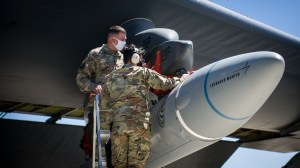Boeing wins $70M contract award for Glide Breaker counter-hypersonic weapons tech

The Boeing Co. has been tapped by the Defense Advanced Research Projects Agency for the next phase of the Glide Breaker program aimed at developing technologies that could help the U.S. military shoot down adversaries’ hypersonic missiles, according to the contractor and the Pentagon.
On Sept. 8, the Department of Defense announced that the company was awarded a $70.6 million cost-plus-fixed-fee contract, excluding one unexercised option, for phase two of the project, but didn’t provide much additional detail.
In a release Monday, Boeing said the firm will “develop and test technologies for a hypersonic interceptor prototype” and “perform computational fluid dynamics analysis, wind tunnel testing and evaluation of aerodynamic jet interaction effects during flight tests.”
It is expected to be a four-year effort, per the release.
Hypersonic missiles pose a unique challenge for U.S. and allied air-and-missile defenses. They are designed to fly faster than Mach 5 and be extraordinarily maneuverable. U.S. adversaries such as China and Russia are developing these types of systems, and the Pentagon is looking for additional tools to counter them.
“This phase of the Glide Breaker program will determine how factors like hypersonic airflow and firing jet thrusters to guide the vehicle affect system performance at extreme speed and altitude in a representative digital environment,” Gil Griffin, executive director of the Boeing Phantom Works advanced weapons office, said in a statement. “We’re operating on the cutting edge of what’s possible in terms of intercepting an extremely fast object in an incredibly dynamic environment.”
Developments associated with Glide Breaker are intended to inform a future program of record as the U.S. military looks for ways to shoot down hypersonics in their glide phase of flight where they may be more vulnerable to intercepts.
The Pentagon is looking for an interceptor that could be launched from an Aegis MK-41 vertical launch system and take out adversaries’ missiles with a kill vehicle enabled by a “divert and attitude control system,” according to a broad agency announcement for the effort released last year.
Phase two of the Glide Breaker program “seeks to develop the knowledge required to enable a DACS-propelled [kill vehicle] to intercept threats during glide phase in the presence of [jet interaction] effects,” per the BAA. Phase one “was a critical step, but did not address endoatmospheric effects such as controlling the [kill vehicle] in the presence of [jet interaction] between the DACS jets and the hypersonic cross flow.”
Meanwhile, DARPA isn’t the only Pentagon component working on counter-hypersonics tech.
In April, the DOD announced that the Missile Defense Agency had extended ongoing contracts with Raytheon and Northrop Grumman to separately refine their Glide Phase Intercept concepts.
And just last month, the U.S. and Japan announced that they will team up to jointly produce a new weapon that can counter emerging hypersonic threats in the Indo-Pacific region, via a Glide Phase Interceptor cooperative development program. Washington and Tokyo are particularly concerned about China’s advancements in hypersonic missile technology.
The U.S. military is also pursuing its own offensive hypersonic missiles, including an Army ground-launched Dark Eagle (formerly known as the Long Range Hypersonic Weapon, or LRHW), a Navy sea-launched Conventional Prompt Strike (CPS) weapon, and the Air Force’s Hypersonic Attack Cruise Missile (HACM).
Additionally, DAPRA has a program known as More Opportunities for Hypersonic Air-breathing Weapon Concept (MoHAWC). In July, the Department of Defense announced that it selected Raytheon and its partner Northrop Grumman to continue the development and maturation of a scramjet-powered hypersonic missile. The new effort is a follow-on to the HAWC program — a joint initiative between DARPA and the Air Force that wrapped up in January with its final successful flight test.






